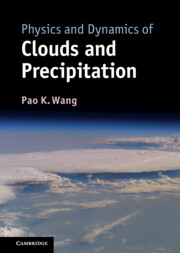Book contents
- Frontmatter
- Contents
- Preface
- 1 Observation of clouds
- 2 The shape and size of cloud and precipitation particles
- 3 Molecular structures of water substance
- 4 Bulk thermodynamic equilibrium among water vapor, liquid water, and ice
- 5 Surface thermodynamics of water substance
- 6 Aerosol in the atmosphere
- 7 Nucleation
- 8 Hydrodynamics of cloud and precipitation particles
- 9 Diffusion growth and evaporation of cloud and precipitation particles
- 10 Collision, coalescence, breakup, and melting
- 11 Cloud drop population dynamics in the warm rain process
- 12 Fundamental cloud dynamics
- 13 Numerical cloud models
- 14 Cloud electricity
- 15 Clouds–environment interaction
- References
- Index
- Plate section
2 - The shape and size of cloud and precipitation particles
Published online by Cambridge University Press: 05 March 2013
- Frontmatter
- Contents
- Preface
- 1 Observation of clouds
- 2 The shape and size of cloud and precipitation particles
- 3 Molecular structures of water substance
- 4 Bulk thermodynamic equilibrium among water vapor, liquid water, and ice
- 5 Surface thermodynamics of water substance
- 6 Aerosol in the atmosphere
- 7 Nucleation
- 8 Hydrodynamics of cloud and precipitation particles
- 9 Diffusion growth and evaporation of cloud and precipitation particles
- 10 Collision, coalescence, breakup, and melting
- 11 Cloud drop population dynamics in the warm rain process
- 12 Fundamental cloud dynamics
- 13 Numerical cloud models
- 14 Cloud electricity
- 15 Clouds–environment interaction
- References
- Index
- Plate section
Summary
The cloud observations that we described in the last chapter are concerned mainly with the exterior appearance of clouds – except for radar and lidar, which also probe the cloud interior – but we did not discuss them in any depth. In this chapter, we want to look into the internal structure of clouds and precipitation. In particular, we want to examine the microstructures, such as the shape and size of the particles that constitute the clouds and precipitation, in some detail.
Clouds as a colloidal system
Clouds are a system of condensed particles of water substance (water drops, ice particles) suspended in a fluid medium (air). Such a system is called a colloid. If the carrier fluid of a colloid is a gas (such as air), the colloidal system is called an aerosol. If the carrier fluid is a liquid (such as water or oil), the colloid is called a hydrosol. You will occasionally find in the literature that clouds are referred to as an aerosol. Thus, for example, the term “Venusian aerosol” sometimes refers to the clouds in the atmosphere of the planet Venus. In the case of the Earth’s atmosphere, however, the term “aerosol” is usually reserved to mean those particles consisting mainly of chemicals other than water (though they may contain a small amount of water too).
- Type
- Chapter
- Information
- Physics and Dynamics of Clouds and Precipitation , pp. 27 - 67Publisher: Cambridge University PressPrint publication year: 2013



